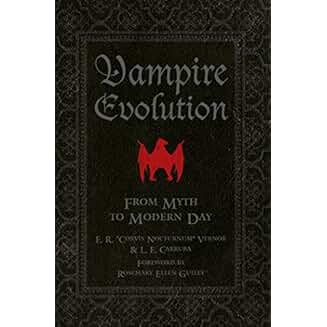Vampire
Evolution – From Myth to Modern Day, E.R. “Corvis Nocturnum” Vernor and L.E. Corruba, Schiffer Publishing, Ltd., Atglen, PA, 2015, 144 pp. $24.99.
Vampire Evolution is a beautiful black hardcover book with a red vampire bat emblazoned on the front. That certainly sets the mood for a great read.
The forward is written by Rosemary Ellen
Guiley, who is well known to vampire aficionados, and Vernor and Corruba thank
well-known colleagues and friends who offered guidance and encouragement,
including Michelle Belanger, Martin Riccardo, Katherine Ramsland, Merticus, and
Guiley.
Vampires are predators, and predators
must evolve in order to survive. The vampire, likewise, has evolved over time
from reanimated corpse to modern day teen heartthrob
blood sucker with stops in between as wraith dressed in tattered burial shroud
and well-dressed Victorian aristocrat.
Vernor and Corruba (hereafter called V
& C) believe vampire lore began in Mesopotamia around 4000 BCE, where improperly buried people returned as Ekimmu, rotting
corpses hunting and killing the living. V & C then explore vampire-like
creatures alluded to in the Bible: Estrie and Aluga, as well as Lilith, Adam’s
alleged first wife who has various forms. As a succubus, Lilith attacks men in
their sleep. As Lamashtu, she harms childbearing women and small children. As V
& C relate myths and legends of vampires across Europe, they cover methods
of dispatching the creatures, which like the vampire, have evolved over time.
The vampire was actually beneficial to
the spread of Catholicism. V & C explain that, as the Church sought to
convert pagans, “church leaders declared pagan practices as heretical and its
ardent followers as witches and demons and began eliminating them, aided by the
first witch-hunter’s manual, the Malleus
Maleficarum.” The Witches’ Hammer,
as it was known, “established Christianity as the sole religious power that
could repel or kill the undead”; thus, vampires fear the crucifix and burn when
splashed with holy water.
With the Church involved, the vampire
evolved. Italian priest Thomas Aquinas decided vampires could transform into
animals, which might have inspired Bram Stoker to have Dracula shift into wolf,
bat and mist.
As Romanticism became popular at the end of
the 18th century, the vampire evolved into “a seductive, androgynous
creature of power and beauty”. The vampire’s bite now had sexual overtones in
fiction and poetry. Johann von Goethe, John Keats, Samuel Taylor Coleridge and
Charles Baudelair wrote about the seductive vampire. Byron not only wrote about
the vampire, but inspired the cold-hearted aristocratic vampire in works by
Lady Caroline Lamb and John Polidori.
V & C trace the vampire’s evolution
to fiction, poetry, and stage plays, Bram Stoker’s Dracula, originally titled The
Un-Dead, revived some of the former traits of the vampire and became an
inspiration that we see even today in film. The vampire evolved as authors such
as Anne Rice and Chelsea Quinn Yarbro brought it into the 20th
century.
V & C’s research is astounding,
showing the vampire’s evolution through film and TV from Murnau’s 1922 Nosferatu, the Hammer films of the
1950s, lesbian vampires and Blacula
in the 1970s, the subtext of AIDS in the 1980s, TV’s Dark Shadows and Buffy the
Vampire Slayer and on to the present with films like Abraham Lincoln, Vampire Hunter.
The evolution continued as fans began
researching the vampire mythos. Some became sanguinarians, consuming blood.
Vampire clubs opened and the advent of the internet connected vampire
aficionados worldwide.
The vampire has indeed evolved, and V
& C trace that evolution marvelously through fiction, film, role-playing
and video games. For those wanting to know more about vampires, or find vampire
fans of like-mind, V & C provide a list of real vampire websites.
I was amazed at how much information was
packed into this average-sized book. The artwork and photos add so much to the
atmosphere of the book. It is a treasure for any fan of the vampire, no matter
what form the creature takes.
- Leslie Hardy

No comments:
Post a Comment